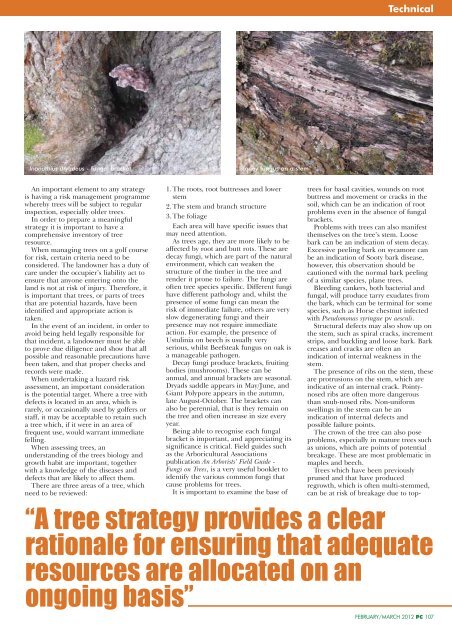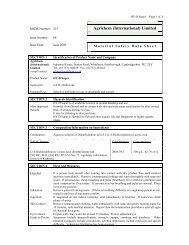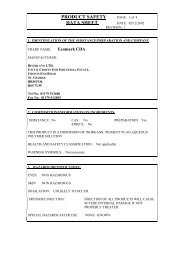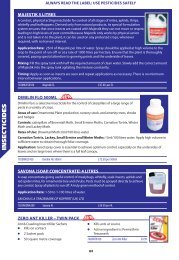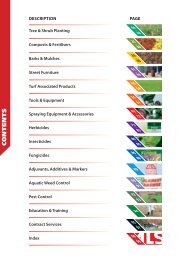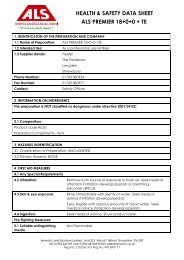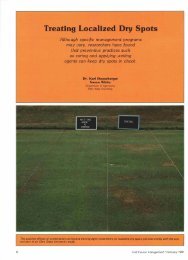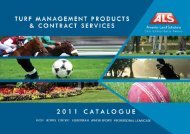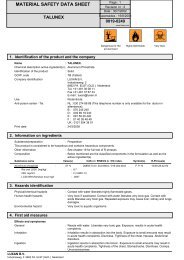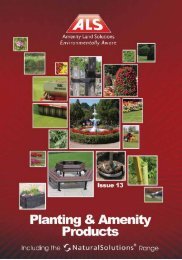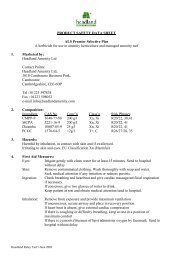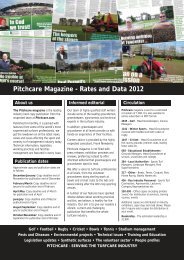these Open Championship Clubs choose to relief grind - Pitchcare
these Open Championship Clubs choose to relief grind - Pitchcare
these Open Championship Clubs choose to relief grind - Pitchcare
You also want an ePaper? Increase the reach of your titles
YUMPU automatically turns print PDFs into web optimized ePapers that Google loves.
Inonothius dryadeus - fungal bracket Honey fungus on a stem<br />
An important element <strong>to</strong> any strategy<br />
is having a risk management programme<br />
whereby trees will be subject <strong>to</strong> regular<br />
inspection, especially older trees.<br />
In order <strong>to</strong> prepare a meaningful<br />
strategy it is important <strong>to</strong> have a<br />
comprehensive inven<strong>to</strong>ry of tree<br />
resource.<br />
When managing trees on a golf course<br />
for risk, certain criteria need <strong>to</strong> be<br />
considered. The landowner has a duty of<br />
care under the occupier’s liability act <strong>to</strong><br />
ensure that anyone entering on<strong>to</strong> the<br />
land is not at risk of injury. Therefore, it<br />
is important that trees, or parts of trees<br />
that are potential hazards, have been<br />
identified and appropriate action is<br />
taken.<br />
In the event of an incident, in order <strong>to</strong><br />
avoid being held legally responsible for<br />
that incident, a landowner must be able<br />
<strong>to</strong> prove due diligence and show that all<br />
possible and reasonable precautions have<br />
been taken, and that proper checks and<br />
records were made.<br />
When undertaking a hazard risk<br />
assessment, an important consideration<br />
is the potential target. Where a tree with<br />
defects is located in an area, which is<br />
rarely, or occasionally used by golfers or<br />
staff, it may be acceptable <strong>to</strong> retain such<br />
a tree which, if it were in an area of<br />
frequent use, would warrant immediate<br />
felling.<br />
When assessing trees, an<br />
understanding of the trees biology and<br />
growth habit are important, <strong>to</strong>gether<br />
with a knowledge of the diseases and<br />
defects that are likely <strong>to</strong> affect them.<br />
There are three areas of a tree, which<br />
need <strong>to</strong> be reviewed:<br />
1.The roots, root buttresses and lower<br />
stem<br />
2.The stem and branch structure<br />
3.The foliage<br />
Each area will have specific issues that<br />
may need attention.<br />
As trees age, they are more likely <strong>to</strong> be<br />
affected by root and butt rots. These are<br />
decay fungi, which are part of the natural<br />
environment, which can weaken the<br />
structure of the timber in the tree and<br />
render it prone <strong>to</strong> failure. The fungi are<br />
often tree species specific. Different fungi<br />
have different pathology and, whilst the<br />
presence of some fungi can mean the<br />
risk of immediate failure, others are very<br />
slow degenerating fungi and their<br />
presence may not require immediate<br />
action. For example, the presence of<br />
Ustulinia on beech is usually very<br />
serious, whilst Beefsteak fungus on oak is<br />
a manageable pathogen.<br />
Decay fungi produce brackets, fruiting<br />
bodies (mushrooms). These can be<br />
annual, and annual brackets are seasonal.<br />
Dryads saddle appears in May/June, and<br />
Giant Polypore appears in the autumn,<br />
late August-Oc<strong>to</strong>ber. The brackets can<br />
also be perennial, that is they remain on<br />
the tree and often increase in size every<br />
year.<br />
Being able <strong>to</strong> recognise each fungal<br />
bracket is important, and appreciating its<br />
significance is critical. Field guides such<br />
as the Arboricultural Associations<br />
publication An Arborists’ Field Guide -<br />
Fungi on Trees, is a very useful booklet <strong>to</strong><br />
identify the various common fungi that<br />
cause problems for trees.<br />
It is important <strong>to</strong> examine the base of<br />
Technical<br />
trees for basal cavities, wounds on root<br />
buttress and movement or cracks in the<br />
soil, which can be an indication of root<br />
problems even in the absence of fungal<br />
brackets.<br />
Problems with trees can also manifest<br />
themselves on the tree’s stem. Loose<br />
bark can be an indication of stem decay.<br />
Excessive peeling bark on sycamore can<br />
be an indication of Sooty bark disease,<br />
however, this observation should be<br />
cautioned with the normal bark peeling<br />
of a similar species, plane trees.<br />
Bleeding cankers, both bacterial and<br />
fungal, will produce tarry exudates from<br />
the bark, which can be terminal for some<br />
species, such as Horse chestnut infected<br />
with Pseudomonas syringae pv aesculi.<br />
Structural defects may also show up on<br />
the stem, such as spiral cracks, increment<br />
strips, and buckling and loose bark. Bark<br />
creases and cracks are often an<br />
indication of internal weakness in the<br />
stem.<br />
The presence of ribs on the stem, <strong>these</strong><br />
are protrusions on the stem, which are<br />
indicative of an internal crack. Pointynosed<br />
ribs are often more dangerous<br />
than snub-nosed ribs. Non-uniform<br />
swellings in the stem can be an<br />
indication of internal defects and<br />
possible failure points.<br />
The crown of the tree can also pose<br />
problems, especially in mature trees such<br />
as unions, which are points of potential<br />
breakage. These are most problematic in<br />
maples and beech.<br />
Trees which have been previously<br />
pruned and that have produced<br />
regrowth, which is often multi-stemmed,<br />
can be at risk of breakage due <strong>to</strong> <strong>to</strong>p-<br />
“A tree strategy provides a clear<br />
rationale for ensuring that adequate<br />
resources are allocated on an<br />
ongoing basis”<br />
FEBRUARY/MARCH 2012 PC 107


